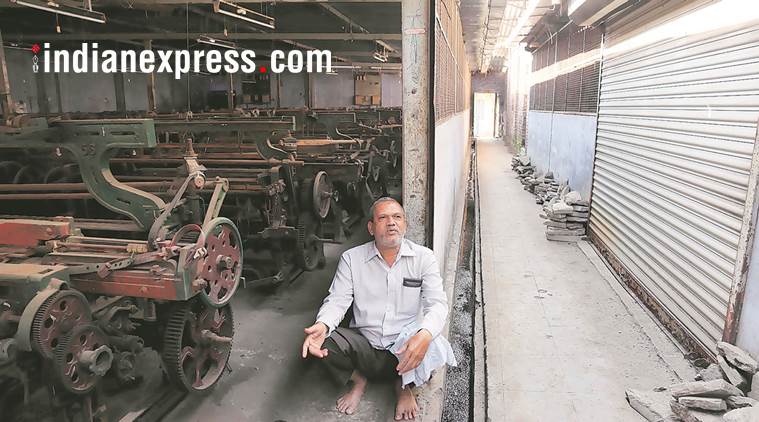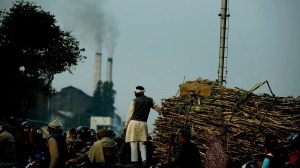- India
- International
Bhiwandi hopes for specific textile export policies
Weavers say 2017 was a catastrophic year for textile industry, expect 2018 to be a promising one
 The year-long slowdown has wiped out capital, pushed Bhiwandi weavers into a debt cycle and created a shortage of labour. (Express Photo by Prashant Nadkar)
The year-long slowdown has wiped out capital, pushed Bhiwandi weavers into a debt cycle and created a shortage of labour. (Express Photo by Prashant Nadkar)
Dust lifts off the ground as 50-year-old Yaseen Ansari walks into his textile manufacturing unit for the first time in two months. Inside, 20-odd powerlooms sit silently, covered in dust and cobwebs. The family-owned textile manufacturing facility, located on a narrow alley of Narpoli in Bhiwandi, has not been operational for almost a year.
A kilometre away, a handful of powerlooms weave ‘fancy’ fabric — white fabric with intricate borders of red and blue – at Iqbal Burhanpuri’s textile unit in Khadipar. A large part of the unit is not operational. He had once sold the fabric for Rs 37 a meter, he said, but is now unable to find traders willing to buy it for Rs 25.
“Bhiwandi’s textile industry has become a casualty of volatile government policies that keep changing every few months. First there was demonetisation, then there was the new tax,” said Ansari, adding that the year 2017 was catastrophic for the state’s textile industry.
Almost a year ago, the alleys in Bhiwandi — one of India’s largest textile hubs, located 20 km northeast of Mumbai — were abuzz with the constant whirring of powerlooms. Today, they wear a somewhat deserted look as many units remain shut. Those that are operational, are only partly so.
The textile industry, which is heavily dependent on cash transactions, had been crippled by the move to ban old Rs 500 and Rs 1,000 notes, announced by the Prime Minister on November 8, 2016. As weavers were still reeling under the impact of demonetisation, the government’s introduction of the Goods and Services Tax (GST) did little to ease the situation.

Five months on, business has picked up only slightly. “Some of the master weavers have been able to mobilise capital and resumed operations. I have been able to start 200 looms,” said Rashid Tahir Momin, former MLA from Bhiwandi, whose family owns around 500 looms.
However, not many weavers are hopeful. The year-long slowdown has wiped out capital, pushed weavers into a debt cycle and created a shortage of labour. While many, including Ansari, have not been able to resume operations, some have even had to mortgage their looms. Now, they work as contractors for other master weavers.
“For the first couple of months after demonetisation, all transactions had come to a halt. Traders were not buying fabric, and labourers left as they were not getting paid. Then came GST, and the traders’ strike in Gujarat. The workers left again. Business was not viable any more,” said Ansari.
Bhiwandi’s labour-intensive textile industry has a decentralised structure, where master weavers own powerlooms, but sublet most of the work to contractors. The conversion of yarn to cloth requires at least 10 levels of work, including transport, sizing, warping, weaving, mending, folding and packaging. Each of these levels require a special set of skills. Most of the workforce are migrants from different parts of the country, and therefore, a labour shortage has severe consequences.
“Once the labourers leave, they don’t return for a couple of months. The remuneration for the job have dropped as master weavers are incapable of paying the usual rates. There’s no incentive to come back,” said Momin.
For Mazhar Zainudeen, work comes occasionally these days. A labourer with expertise in mending and weaving, Zainudeen said he would earn Rs 12,000 a month when there is work. “Until last year, I would earn up to Rs 16,000 a month, and there was regular flow of work,” he said.
“We have seen bad phases in this line of work, but this year has been unlike any other. It has discouraged my children from pursuing the family business. Unless there are specific policies to promote textile export, the future appears dark,” said Burhanpuri, whose family has been in the business for generations.
It is not the policies that many weavers have a problem with, but how they are implemented. “GST is a welcome move for the textile industry as it promises to eliminate middlemen. But, the government cannot announce policies on an experimental basis and make changes along the way. That is not conducive for any business. Policies have to be robust and well implemented,” Momin said.
Apr 25: Latest News
- 01
- 02
- 03
- 04
- 05







































